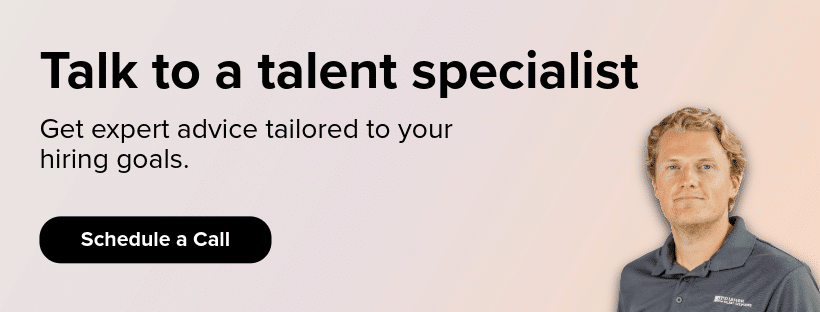
Hiring someone who doesn’t work out stinks.
You spend weeks sourcing, screening, and interviewing. You think you’ve found the right person. But within a few months, the warning signs start to pile up, and now you’re back to square one with a frustrated team and an even harder role to fill.
It’s tempting to blame the candidate, the market, or even bad luck. But often, the real issue starts inside the interview room, whether you know it or not.
Most teams don’t receive any formal interview training. Managers rely on instinct, peers ask whatever comes to mind, and there’s no structure, alignment, or real way to compare one candidate to the next.
And that’s how good companies end up making bad hires.
In this article, I’ll unpack how untrained interviews can derail hiring efforts, and what you can do to fix it.
How Poor Interviewing Skills Can Lead to Bad Hires
Most people assume that being a good interviewer is intuitive. You’ve worked with people, and you know your team, so you’ll know a good candidate when you see one, right?
Not always.
Things can break down if interviewers:
- Ask inconsistent questions
- Make snap judgements based on personality
- Talk more than they listen
- Fail to assess critical job skills
When an interviewer doesn’t know how to probe, evaluate, or compare candidates in a structured way, hiring becomes a guessing game. And usually when we guess, we miss. We either hire someone who can’t do the job or overlook someone who could have been amazing.
5 Common Interview Mistakes (and Why They Happen)
Even experienced hiring managers fall into these traps sometimes.
Mistake #1: Relying on Gut Instinct Alone
What it looks like: A hiring manager wraps up an interview and says, “I can’t explain it—I just didn’t get a good vibe.”
Why it’s a problem: Gut instinct is often code for unconscious bias. It often hides behind word like “fit” or “vibe.” When we rely on feeling instead of evidence, we open the door to hiring people who are like us, not necessarily the best fit for the job. Treat it like a final filter, not your starting point.
What to do instead: Use a structured scorecard to evaluate specific skills or traits tied to the role. For instance, if “collaboration” is a key competency, define what that looks like and rate candidates based on behavior, not just personality.
Mistake #2: Asking the Same Generic Questions
What it looks like: Interviewers stick to vague questions like “Tell me about yourself,” “What are your strengths?” or “Where do you see yourself in five years?”
Why it’s a problem: These questions don’t uncover real capabilities. They lead to rehearsed answers and don’t help the interviewer assess if the person can actually do the work.
What to do instead: Ask behavioral questions that tie directly to the role. For example: “Tell me about a time when you had to work through a disagreement with a teammate. What was the situation, and how did you handle it?” This gives you insight into past behavior, which is a better predictor of future performance.
Mistake #3: Asking Illegal Questions
What it looks like: An interviewer asks, “Do you have kids?” or “Where are you from originally?” thinking they’re just making conversation.
Why it’s a problem: Even seemingly harmless small talk can cross legal lines or introduce bias. It puts the company at risk and can make candidates feel uncomfortable or excluded.
What to do instead: Train every interviewer on which questions are off-limits and why. Instead of small talk that veers into personal territory, focus on asking consistent questions about work style, decision-making, or motivation.
Mistake #4: Talking Too Much During the Interview
What it looks like: The interviewer spends most of the time explaining the company, the role, or sharing their own experiences. While this should be part of the interview, it becomes a problem when it’s so much that the candidate barely gets a word in.
Why it’s a problem: When interviewers dominate the conversation, they don’t learn enough about the candidate to make a good decision. Worse, they may unintentionally lead the candidate to give the “right” answer.
What to do instead: Use the 70/30 rule—aim to listen 70% of the time and speak 30%. Prepare a short, clear overview of the role and company at the start, then transition into open-ended questions and let the candidate carry the conversation.
Mistake #5: Failing to Align with the Team
What it looks like: Hiring team misalignment may look like each interviewer asking whatever comes to mind. There’s no shared rubric or alignment on what “good” looks like for this role.
Why it’s a problem: This leads to inconsistent experiences for candidates and makes it hard to compare feedback. One person may love a candidate’s personality; another may think they’re underqualified. Neither has a common framework to guide the decision.
What to do instead: Run a short pre-brief with your interview team before interviews begin. Assign focus areas (e.g., technical skills, culture contribution, collaboration style), agree on the scorecard, and define success metrics up front.
What a Bad Hire Costs Your Company
According to a CareerBuilder study, 74% of small businesses admit they’ve hired the wrong person. And the U.S. Department of Labor estimates that wrong person can cost the company up to 30% of their first-year salary.
Here’s what factors into that loss:
- Onboarding and training that goes nowhere
- Lower productivity and morale across your team
- Damage to customer relationships or internal credibility
- Restarting the entire recruiting process from scratch
Multiply that by a few misfires, and the numbers climb quickly.
What a Good Interview Training Should Include
Interview training might sound like overkill, but it’s not about memorizing scripts or turning managers into recruiters. It’s about alignment, consistency, and clarity.
When interviewers are trained, they ask better questions, stay focused on the role instead of personal bias, document what they hear and evaluate it fairly, and create a more consistent (and fair) candidate experience.
And here’s the kicker: Candidates feel the difference. Great people want to work at companies that feel buttoned-up, not fly-by-the-seat-of-your-pants.
You don’t need a three-day bootcamp to get this right, but you do need to cover the basics.
- Structured interviewing – Teach interviewers how to prepare questions aligned with the role and how to use scorecards.
- Legal guardrails – Make sure everyone knows what they can and can’t ask. A quick compliance refresher goes a long way.
- Behavioral interviewing – Move beyond hypotheticals (“What would you do if…”) to real stories (“Tell me about a time when…”).
- Evaluating with consistency – Create a simple rating system across competencies and make expectations crystal clear.
- Interviewer calibration – Bring your hiring team together to align on what “good” looks like for this specific role, and what’s “need-to-have” vs. “nice-to-have.”
Who Needs Interview Training? And When?
Short answer: pretty much everyone who touches the hiring process.
- HR and recruiters – to ensure alignment on key skills needed
- Hiring mangers – to guide consistency and stay compliant
- Peer interviewers or team members – to avoid bias and stay objective
You should run interviewing training before a big hiring push, when promoting a first-time manager, after making a regrettable hire, and when launching a new interview process or department.
Interview Training Tools and Templates To Use
You don’t have to start from scratch. There are a ton of tools hiring teams are using to train interviewers effectively. Here are a few I recommend looking into.
| Tool | What It Does | Best For |
|---|---|---|
| Google Docs/Microsoft Word Interview Scorecard Template | Helps interviewers rate candidates by skill area using a consistent rubric | Any company |
| ATS Structured Interview Kits | Built-in guides and scoring inside your ATS | Teams already using an ATS, such as Lever or Greenhouse |
| LinkedIn Talent Hub Question Bank | Curated role-based interview questions | Teams new to structured interviews |
Ready to Train Your Team?
If you’re stuck second guessing hires or seeing top candidates drop out, interview training is a great remediation. Build interview confidence and consistency across your team and turn your hiring process into a competitive advantage.
If you need help getting started, let’s talk. We can run interview workshops that show you what a simple, effective rollout could look like or go as far as running interviews alongside you.





